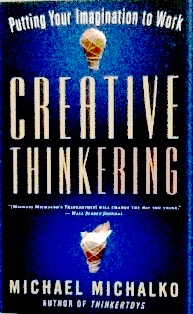
Think of something that is impossible to do, but if it were possible to do, would change the nature of your business forever? Then try to come up with ideas that take you as close as possible to make that impossibility a reality.EXAMPLE: A non-profit in Russia was concerned that over 30 percent of Russian drivers failed to comply with parking regulations concerning disabled spaces. The impossibility they imagined was to hire disabled people to park in wheelchairs in the parking spaces to ward off people trying to take the disabled places.
IMAGINEERING. Then they brainstormed for ideas to come as close to this impossibility as possible. How can we imagineer this into a realistic and practical idea?
IDEA: The idea they settled on was to use projections of real disabled people to ward off people who try to take disabled spaces. The system uses a camera which can detect whether or not a driver has a disabled sticker in their windshield — a hologram appears to confront them if they don’t. The image is projected onto a thin, water mist screen, which is initially invisible to the public eye. When the system detects an offender, a projection appears in the form of a disabled individual and says, ‘Stop. What are you doing? I’m not just a sign on the ground. Don’t pretend that I don’t exist.’
Another impossible idea they imagined was to deputize every resident and give them the authority to ticket and fine offending parkers. They imagineered this by introducing warning tickets designed to look like parking tickets. The tickets can be printed and issued by anyone and placed on any car wrongly parked in a disabled space. This campaign enables all residents to lend a helping hand. Participants are encouraged to place them on cars which they find wrongly parked in disabled bays. The tickets look like parking fines and feature text reminding the recipient of the importance of refraining from using the spaces.
When the non-profit participants imagineered the impossibilities, their minds decomposed them into several parts and then focused on the interesting parts to build ideas. This focus on the interesting parts is what inspired the new insights and ideas.
In another example the owners of a nightclub wanted to issue unique personal invitations to their grand opening. They started their brainstorming session with the question (What is impossible to do but if it were possible would….?) They generated many interesting and amusing ideas such as create a plant that sprouts an invitation, fit prospect’s chairs with a sensor so that, when a prospect sits, the chair invites the person.
The one idea they worked with was to have the invitation magically appear on their prospect’s desk while they are sitting at it. They worked with this idea into the the following result. The club sent out a blue pill nestled in black velvet ring. On top of the box was written “This is a magic pill that we guarantee will make you happy. Inside the box the instructions read “Drop into warm water, stir and let dissolve.” When the pill was immersed the capsule dissolved and bubbled, and a piece of cellophane with the date, time and place of the grand opening floated to the top. The invitations cost one dollar and the grand opening was a huge success.
…
(Michael Michalko is the author of Thinkertoys: A Handbook of Creative Thinking Techniques; Cracking Creativity: The Thinking Strategies of Creative Geniuses; Thinkpak: A Brainstorming Card Deck, and Creative Thinkering: Putting Your Imagination to Work.
CREATIVE THINKERING BOOK REVIEW
BOOK REPORT FROM MURPHY BUSINESS REVIEWER: CHRISTOPHER BOND
We read ’em, so you don’t have to! As the nuns used to say, put on your thinking caps. Remember that, when you’d have to fake-tie on your cap? (No, well this would be a good time to make fun of me, now wouldn’t it?) This month’s selection, Creative Thinkering by Michael Michalko, is like one long session with Sister Helen Margaret and the thinking cap. Michalko takes the reader through numerous thought experiments and exercises centered on the random approach to thinking and problem solving. Like last month’s recommended book, Tribal Leadership, this one is perfect for the business leader who is stuck and in need of new approaches to day-in-and-day-out challenges. With a cup of da Vinci here, a dose of van Gogh there, and a pinch of Picasso for good measure, this book reads like a Renaissance recipe for those in need of more creativity.
One of the key takeaways here comes toward the end, when the author challenges the reader with something he calls “the word pattern of impossibility.” Let’s say you don’t consider yourself to be the creative type; Michalko would say that you’ve likely stopped striving to become so. To address this malaise, he takes the reader through new ways of thinking to get from “I can’t be creative” to “I will be creative.” If you’re hearing a big of Stuart Smalley here, you’re not far off. (Let’s face it, you’re not going to tackle self-limiting thinking without it coming off as, “I’m good enough, I’m smart enough, and doggone it, people like me!”) But if you can get beyond that, you’ll find value in the author’s recommendations to go from impossibility, to possibility, to necessity, to certainty, to desire. His experiments are simple yet highly effective. The stories about utterly random strategies to overcoming tough challenges are remarkable, notably how one would-be author overcame the classic Catch-22 struggle of you can’t be published without an agent/you can’t get an agent if you’re not published that has to read twice to be believed.
The recurring theme in Creative Thinkering is that there are ways to return to our formative years, when spontaneity and creativity came naturally. Michalko claims that our schools ruined us for thinking, that it’s as if “we entered school as a question mark and graduated as a period.” And he hammers the point that “we see no more than we expect to see.” Retold here is the wonderful social experiment conducted by The Washington Post years ago, through which a world-class violinist, playing intricate material on a $3.5 million instrument in a Metro station was virtually ignored by everyone save for children who tried to stop and listen. Adults assumed a bum was playing for tips; children heard what was real – a rare talent who had sold out a concert hall two days before. If you’re up for starting 2013 by taking a different tack to your average day’s occurrences, this book will surely help you get there.
KUDOS FOR CREATIVE THINKERING
Kudos from abroad from Aibek Ahmedov Legal Counsel at Europe Marine Group Ltd5h
There are three persons in the world that I find motivating in my path to professional heights. It is Neil Patel, Michael Michalko and Mark Forsyth. However, one of them is a genius of creative thinking that made me change all my approaches to historical research, legal casuistry and content marketing.
I believe that the years will pass and after many years or maybe centuries, people will put Michael Michalko after Leonardo da Vinci in terms of creative thinking. My words are not an exaggeration and I recommend to all my colleagues and friends to read Michalko’s Creative Thinkering in order to understand what I was talking about.

http://www.amazon.com/dp/160868024X/ref=cm_sw_r_tw_dp_XUhvxb0YKA63R … via @amazon